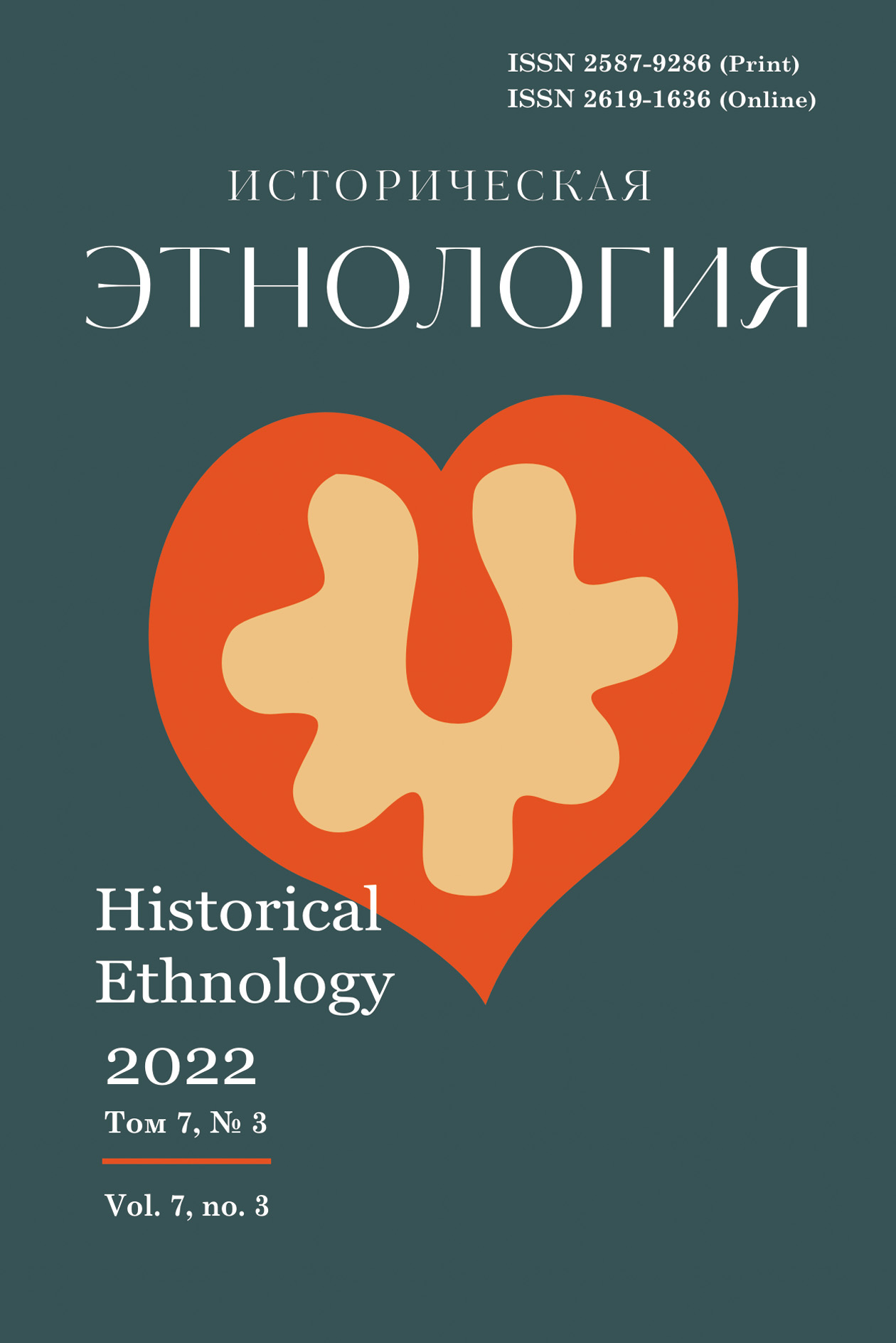Mazars as memorial monuments of Karakalpakstan of the 18th – early 20th centuries
Karlibaev M.A.
414-431 p.
doi.org: https://doi.org/10.22378/he.2022-7-3.414-431
The article studies the monuments of grave architecture of the Karakalpaks of the 18th – early 20th centuries: uishik, sagana, fence and gumbez. The most common form of such buildings is a fence of adobe walls, which does not have coatings. In fact, they were built around the burial place of the deceased, while the gumbez, or domed mausoleum, was often built next to the burial place. Sagana is a closed building, built over the burial. It essentially repeats the shape of an uishik – a tombstone made of different reeds. If the sagana and the fence have analogies among the neighboring peoples – Kazakhs and Uzbeks, then the Karakalpak gumbez is a unique monument of material culture.
Fences in the region of the South Aral Sea, which includes Karakalpakstan, were formed in the Middle Ages. There is an opinion that the appearance of the Muslim mausoleum (gumbez, dome) is associated with the Arab tent "kubba" for praying over the grave of the deceased. The "mausoleum tradition" in the burial culture of Muslims spread far beyond the Aral Sea region. A special reverence for the cult of saints, strongly associated with Sufism, could be the culture of the previous period (for example, the Golden Horde), against which the construction of domed mausoleums was widely spread.
The literature also mentions another type of buildings – zhai, which, from the author’a pointof view, is an intermediate type between a fence and a gumbez. Karakalpaks call the actual fences "zhai", as among the Kazakhs the word "tam" (house) is used. Kazakh fences are distinguished by the presence of corner tops – "tort qulaq" (four ears). In the 20th century in Karakalpakstan, the most common type of tomb structures became just this type – fences made of burnt bricks with four finials at the corners. Architectural monuments as objects of the material culture of the people require special attention from both the public and the state, they need measures to preserve and protect them.
Keywords: Karakalpakstan, Mazar, Architecture, Gumbez, Mausoleum, Cult, Islam
For citation: Karlibaev M.A. Mazary kak memorial'nye pamyatniki Karakalpakstana XVIII – nachala XX vv. [Mazars as memorial monuments of Karakalpakstan of the 18th – early 20th centuries]. Istoricheskaya etnologiya, 2022, vol. 7, no. 3, pp. 414–431. https://doi.org/10.22378/he.2022-7-3.414-431 (In Russian)
REFERENCES
Allamuratov A. Unikal’nyy pamyatnik. [A Unique Monument]. Vestnik Karakalpakskogo filiala Akademii Nauk UzSSR, 1986, no. 4, pp. 57–62. (In Russian)
Babadzhanov B. Kokandskoe khanstvo: vlast’, politika, religiya [The Kokand Khanate: Power, Politics, Religion]. Tashkent-Tokio: Yangi Publ., 2010. (In Russian)
Beatrice F. Manz. Central Asian Uprising in the Nineteenth Century: Ferghana under the Russians. Russian Review, 1987, no. 3, pp. 267–281.
Esbergenov Kh. K voprosu ob izzhivanii religioznykh predstavleniy i obryadov u karakalpakov (na materiale pogrebal’noy obryadnosti). Diss. … kand. ist. nauk [Revisiting the Question of the Expiration of Religious Ideas and Rituals among the Karakalpaks (Based on Funeral Rituals). Cand. Sci. Hist. Diss.] Moscow, 1963. (In Russian)
Esbergenov Kh. Qonyrat. Tariykhyy hám mádeniy estelikleri [Kungrat. Historical and Cultural Monuments]. Nukus: Bilim Publ., 1993. (In Karakalpak).
Goldziher I. Kul’t svyatykh v islame: Mukhammedanskie eskizy [The Cult of Saints in Islam: Mohammedan Sketches]. Moscow, 1938. (In Russian)
Iz istorii sufizma: istochniki i sotsial’naya praktika [From the History of Sufism: Sources and Social Practice]. Ed. M. Khairullaev. Tashkent: Fan Publ., 1991. (In Russian)
Kamolov Kh.Sh. Istoriya mazarov severnogo Tadzhikistana. Avtoref. diss. … kand. ist. nauk [The History of Mazars of northern Tajikistan. Abstract of Cand. Sc. Hist. Diss.]. Dushanbe, 2002. (In Russian)
Khakimniyazov Zh. Obshchestvenno-kul’tovye i memorial’nye sooruzheniya Khorezma Kh. XV vv. (istoriko-arkheologicheskoe issledovanie). Diss. … kand. ist. nauk [Social, Religious and Memorial Buildings of Khorezm in the 10th–15th centuries (historical and archaeological research). Cand. Sci. Hist. Diss.]. Samarkand, 1999. (In Russian)
Khodzhaniyazov G. Kalmak-kala – tsentr karakalpakov XVII–XIX vv. [Kalmak-kala – the center of the Karakalpaks of the 17th–19th centuries]. Arkheologiya Priaral’ya, vol. VII. Tashkent: Fan, 2008, pp. 93–107. (In Russian)
Khodzhaniyazov G. Karakalpaki v Priaral’skom mikrorayone v XVI–XVII vv. [Karakalpaks in the Aral Microdistrict in the 16th–17th Centuries]. Arkheologiya Priaral’ya, vol. VII. Tashkent: Fan, 2008, pp. 159–163. (In Russian)
Khozhaniyazov G., Yusupov O. Qaraqalpaqstandaghy mukhaddes orynlar [Sacred Places in Karakalpakstan]. Nukus: Poligraf Publ., 1994. (In Karakalpak)
Kristensen W.B. The meaning of religion. Introduction by H. Kraemer. Leiden (The Hague), 1960.
Kubel’ E. Namogil’nye sooruzheniya karakalpakov (po materialam ekspeditsii 2012 g.) [Burial Structures of the Karakalpaks (based on the materials of the 2012 expedition)]. Lavrovskiy sbornik. Materialy XXXVI i XXXVII Sredneaziatsko-Kavkazskikh chteniy 2012–2013. Etnologiya, istoriya, arkheologiya, kul’turologiya. Saint Petersburg: MAE RAN Publ., 2013, pp. 248–253. (In Russian)
Litvinov P.P. Gosudarstvo i islam v Russkom Turkestane (1865–1917) (po arkhivnym materialam) [State and Islam in Russian Turkestan (1865–1917) (based on archival materials)]. Elets: Eletsk State Teacher-Training Institute Publ., 1998. (In Russian)
Muminov Ashirbek. Veneration of Holy Sites of the Mid-Sïrdarʼya Valley: Continuity and Transformation. Muslim Culture in Russia and Central Asia from the 18th to the early 20th centuries, ed. Michael Kemper, Anke von Kügelgen, Dmitriy Yermakov. Berlin: Klaus Schwarz Verlag, 1996, pр. 355–367.
Nekrasova E. Dakhma. Islam na territorii byvshey Rossiyskoy imperii. [Dakhma. Islam on the Territory of the Former Russian Empire]. Entsiklopedicheskiy slovar’. Vol. 2. Moscow: Vostochnaya Literatura Publ., 1999, pp. 31–32. (In Russian)
Ogudin V.L. Mesta pokloneniya Fergany kak ob”ekt nauchnogo issledovaniya. [Places of Worship of Ferghana as an Object of Scientific Research]. Etnograficheskoe obozrenie, 2002, no. 1, pp. 63–78. (In Russian)
Qaraqalpaq tilining tusindirme sozligi [Explanatory Dictionary of the Karakalpak Language]. Vol. III. Ed. М.Kalenderov. Nukus: Karakalpakstan, 1988. (In Karakalpak)
Urazbaeva U. Tas medrese [Stone Madrasah]. Vestnik Karakalpakskogo filiala Akademii Nauk UzSSR, 1985, no. 2, pp. 80–82. (In Karakalpak)
Vasil’ev D.V., Zilivinskaya E.D., Rudakov V.G. Polupodzemnye pogrebal’nye sooruzheniya v Zolotoy Orde. [Semi-underground Burial Structures in the Golden Horde]. Kaspiyskiy region: politika, ekonomika, kul’tura, 2012, no 1, pp. 14–21. (In Russian)
Yusupov O. Iyshan-qala [Ishan-kala]. Vestnik Karakalpakskogo filiala Akademii Nauk UzSSR, 1984, no. 1, pp. 64–67. (In Karakalpak)
About the author: Makset A. Karlibaev, Dr. Sc. (History), Deputy Director of the Karakalpak Research Institute for the Humanities, Karakalpak branch of the Uzbekistan Academy of Sciences (179A, Amir Temur St., Nukus 230100, Karakalpakstan, Republic of Uzbekistan); karlmaks@yahoo.com
Received June 5, 2022 Accepted for publication August 1, 2022
Published Online December 15, 2022
|
|








